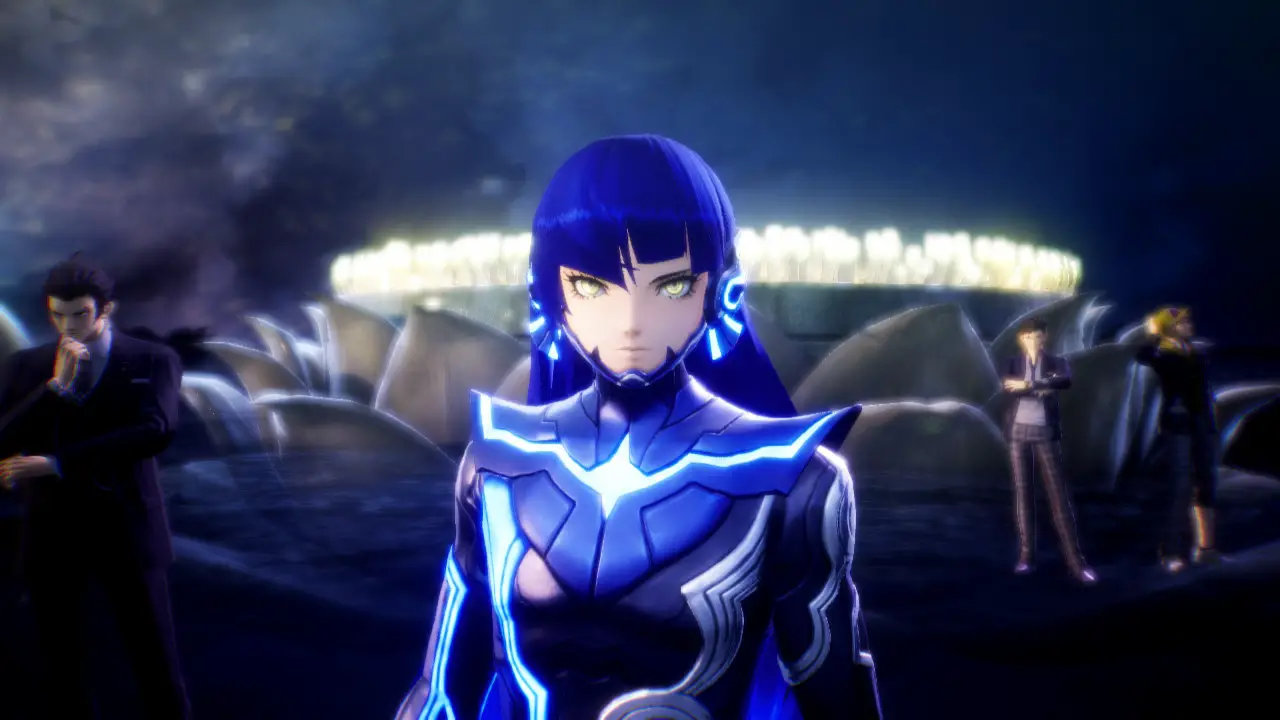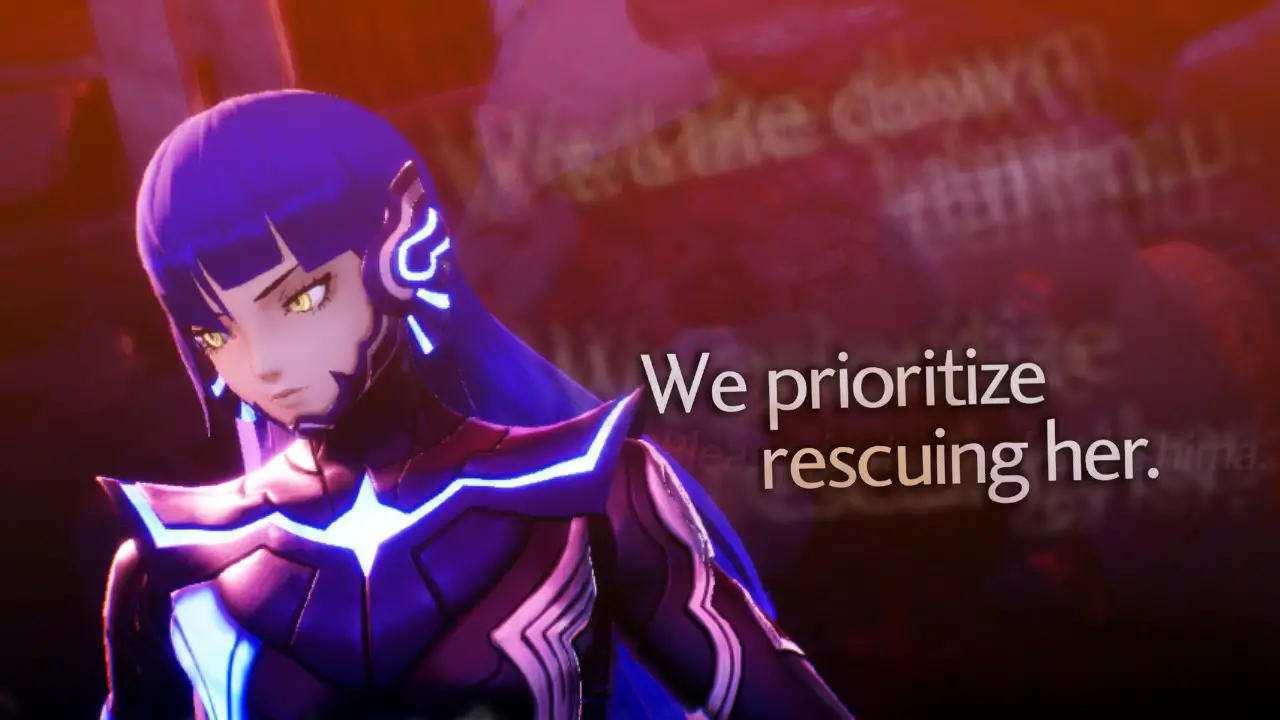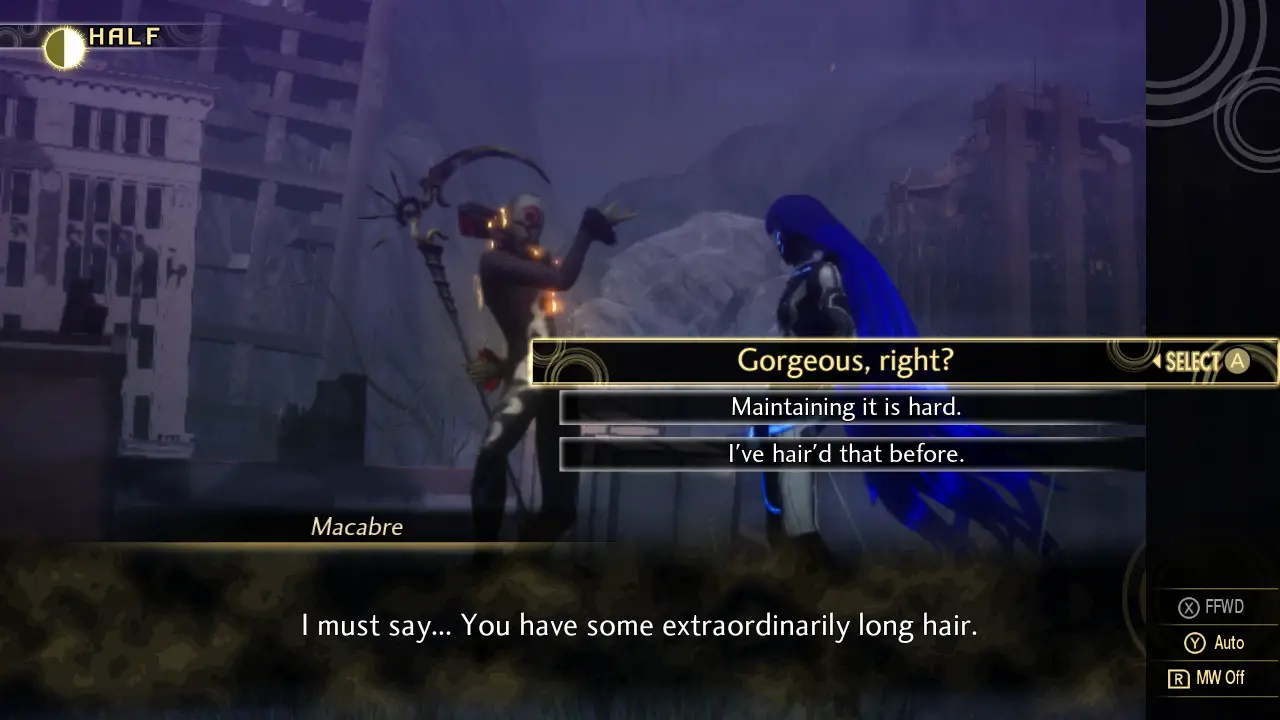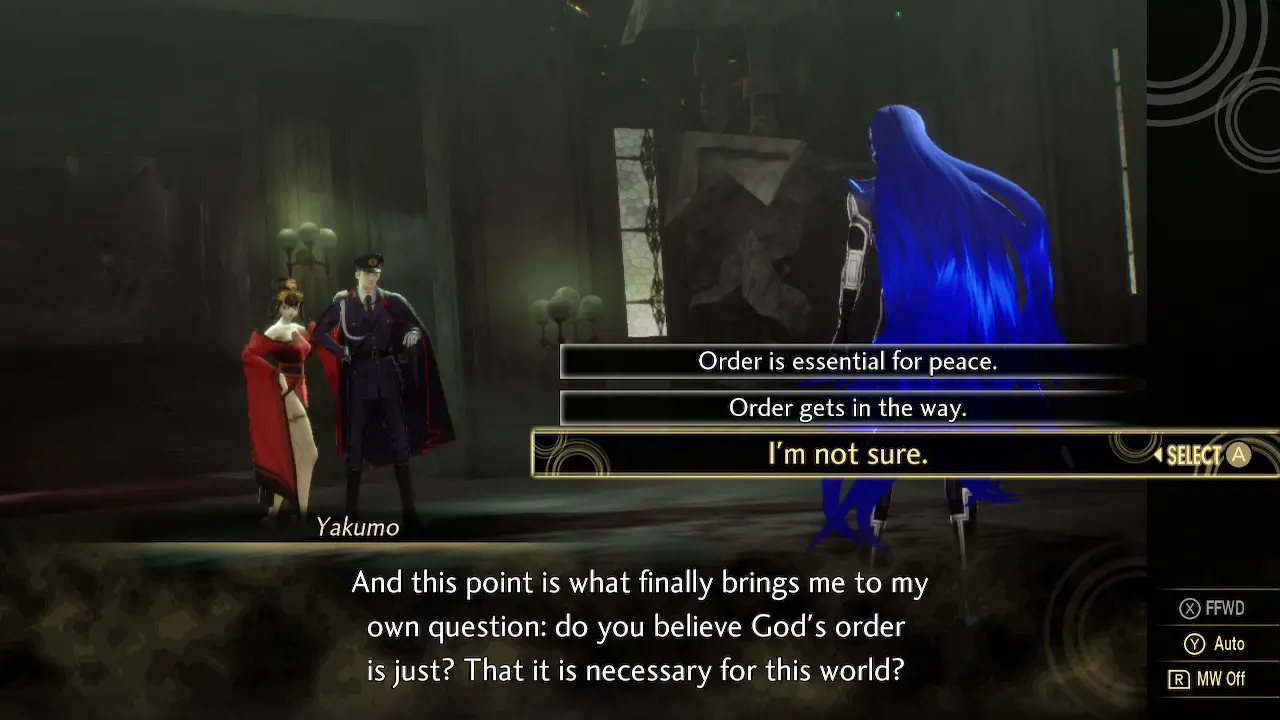
God is dead. 18 years ago, Lucifer defeated the Creator, and brought about the Da’at; a barren world which yearns for a Nahobino as its ruler. However, in His last breath, God safeguarded Tokyo, where humans now live oblivious to the true state of the universe. One of these humans, a high school student, is dragged into the Da’at without warning. A demon by the name of Aogami swears to protect him, when suddenly the two fuse and become the heretical Nahobino, a being capable of changing the world. As man, demon, and god alike curry your favor or attempt to become Nahobino themselves, what path awaits you? One of light, darkness, or something else entirely?
Shin Megami Tensei is a very special series, one that toes the line between commercial product and artistic work. Typically, each numbered game is an examination of the dichotomy between order and chaos, how the two collide and coexist. Too much order leaves little room for freedom, while extreme chaos creates a world where only the strong survive. Atlus explores these themes using figures from mythologies and religions across the world, and they don’t always play the roles you might expect. Each game explores new aspects of these themes and V is no exception, with some very interesting and difficult choices.
SMTV feels like a retelling of the third game, Nocturne, which was remastered earlier this year. In fact, a Nahobi-no-kami could be considered something akin to a demi-angel, the opposite of Nocturne’s demi-fiend, a force to correct the gods rather than destroy them. The Da’at even looks like a vortex world, but I digress. Early on in your journey, you meet the characters who represent each side in the conflict. There are four other students contending with angels and demons in parallel with you, but only two end up mattering and none of them get enough spotlight for me to really care about any of them. While the plot itself is excellent, the characters may just be the weakest out of any modern SMT game, especially when put up against IV’s cast of Samurai, which this game borrows the color symbolism from.
Their holy and hellish counterparts take center stage here, which feels like a missed opportunity given the game’s focus on duality. Even the protagonist’s partner, Aogami, feels like an afterthought apart from a few moments in which he asks your opinion on events. By far the most fleshed out character is a demon by the name of Amanozako, who is absolutely adorable. If anything happened to her I would kill everyone in this room and then myself, but even she gets shoved off into optional content halfway through the game. It could be the route I ended up taking, but the characters in V felt more like cardboard standees promoting ideals rather than characters. Those ideals are incredibly interesting, but they could have been elevated to new heights through characters with reasons to follow them.

While I may have gripes with the characters’ writing and development, their designs are some of the best gaming has to offer. Kazuma Kaneko’s art style has always translated perfectly into 3D, but the demons in this game are on a new level. The game’s stunning visuals compliment these provocative and symbolic designs well, even if the characters are lacking in personality you can really get a feel for who they are with their look. While the main characters may not have been designed by Kaneko, they can convey quite a bit along with the top tier voice acting. In particular, I adore the Nahobino’s androgenous design, conveying that he is in between or outside all things rather than choosing a side. It would have been nice to be able to choose his pronouns along with this, but it’s still cool to see gender non-conforming characters.
Speaking of visuals, you can probably tell from these screenshots and footage that Shin Megami Tensei V is a stunner. The color palette can be a bit too washed out in areas, but this is by far the best the franchise has ever looked with massive and detailed locations to explore. I really want to see what this game looks like on the OLED Switch so the demons really pop out on the screen. Unfortunately, performance is another story entirely. The frame rate appears to be unlocked and, while it might reach 60 while you’re looking at certain parts of the ground, you’ll mostly be exploring at far below 30 frames per second. Atlus has informed us that the day 1 patch will only fix minor issues like typos, but hopefully they can clean it up a bit in the future. It’s not a dealbreaker, battles perform fine and are turn based anyway, but quite a few cutscenes later on in the game can drop an unacceptable amount of frames. Epic Games showed up in the credits, so perhaps the game will be coming to PC later on where frame rate will be a non-issue.

Those frame rate issues stem from V having several massive, open-ended areas to explore. They’re not exactly open world, there’s a path you follow through them in all but the last one, but they certainly allow for ample exploration and alternate paths. These locations are amazingly well designed and utilize their space to the fullest. Each knows when to guide the player to continue the story and when to open up for a beautiful vista or even where to put platforming challenges to reach secret areas or find treasure.
Hidden throughout the world are Miman, little demons who got lost while working for the game’s shopkeeper, Gustave. These little guys and gals are everywhere, and finding ever increasing numbers of them will get you rewards like permanent stat increasing items for demons or the Nahobino along with small amounts of Glory. From these or through treasure chests, you’ll also acquire demon essences, which brings us to fusion. In the World of Shadows, Sophia provides a service called Apotheosis. Here, you spend Glory to acquire bonuses like healing upon level up, increasing your skill slots and demon stock, and much more. You can also fuse essences to anyone in your party, allowing them to learn skills they normally wouldn’t be able to through leveling. This is the only way to give the Nahobino new skills and change his elemental affinities. It’s a fun and versatile system that compliments the standard fusion system very well.

Fusion itself feels like one step forward one step back in a way. You can simply choose two demons to fuse together, fuse by the result you want, and fuse by result including demons registered in the compendium. Finally, meeting certain requirements will allow you to fuse special demons you can’t acquire through negotiation. You may notice that sacrificial fusion, where you sacrifice one demon to power up another, is conspicuously absent from this list. It hasn’t been in every game in the series, but it would have been helpful here and complimented the essence fusion given that you’re incentivized to pick a few demons and develop their skills and stats as you level and fuse them.
As per usual you get new demons by negotiating with them in combat. If they’re in the mood (i.e. the moon phase hasn’t made them go into a frenzy), they’ll ask you a set of strange questions. Provided your answers are to their liking (it’s random) they’ll then demand gifts like money or items, and only then if they’re satisfied will they join your party. Demon Negotiation is love it or hate it for most people (I love how absurd it is), but it overall feels easier. This may be partially due to the RNG being more in your favor, but conveniently if you succeed in a negotiation but the demon can’t join your party later on, the game will remember this and allow you to pick them up later on without going through the whole process again. The biggest obstacle to recruiting is now levels, which can be pretty uneven.

Shin Megami Tensei V is surprisingly grind heavy. About halfway through the game, you’ll stumble into a boss that is about 5 levels higher than you, which is a bit frustrating but doesn’t take too long. Near the end of the game, however, you have to grind about 20 levels, absolutely halting story progress. Given that normal enemies can already one shot your party occasionally, this becomes very frustrating. If the protagonist dies, it’s back to the title screen with no autosave, no continues, and going back to your last save. To get this review done on time, I did switch from normal down to casual after 35 hours of playing on the former for the game’s final 10 hours.
While the leveling curve could be more balanced, combat itself is still just as fun and nuanced as it always is. The Press Turn system returns in full force here, with icons representing each action you can take in a turn. Going in party order, if a character lands a critical hit or exploits an enemy weakness, they only consume half of an icon, lengthening the total amount of actions in a turn. Conversely, if you miss or an attack gets reflected, this will consume more than one icon. Enemies play by the same rules too, so you want to consider your party skills and affinities before a battle so you can maximize your actions and minimize theirs. The best feeling is getting destroyed by a boss, then coming back later with a party that they can’t even hit.

You also have access to Magatsuhi attacks which grant your party special buffs for one turn. The gauge in the top right of the screen will fill up as you fight, and once full you can spend it on one of these moves. Many demons have additional skills, but everyone possesses one which makes every attack critical for the remainder of the turn. These are free to use and I can’t even count the number of times they saved my butt. Magatsuhi doesn’t feel like a huge curveball, but it compliments the other mechanics very nicely.
There have been a few changes to the battle system even if it is largely the same. Light and dark skills still deal damage much like more recent games, but their insta-kill potential has returned as a random chance side effect. Some demons also have unique skills that don’t transfer with fusion or affinity inheritance. For example, one of the new demons is Idun, who possesses a healing skill which also buffs the entire party’s attack, defense, and accuracy. Because of these, you may want to keep a demon around longer rather than fusing them; Idun served as my healer for a majority of the game. The Nahobino can also acquire skills like these, like some incredibly powerful almighty attacks. There is quite a lot to consider both in and out of combat, which is bound to make every playthrough at least a bit different.

While it took a bit to grow on me, the music is absolutely fantastic. The normal battle theme is probably the weakest track, but some of the boss themes rival my favorites in other games. Headphones are a must because of the intricate soundscapes when exploring, killer tunes, and incredible voice acting.
Shin Megami Tensei V
Excellent
Shin Megami Tensei V is a masterfully made JRPG and fascinating work of art. While the characters could have used more fleshing out and the leveling curve is wildly uneven, it’s still incredibly fun with thrilling combat and a gripping plot.
Pros
- Combat is brutal and enjoyable
- Gorgeous visuals and music
- Amanozako
- Great story…
Cons
- ...but one note characters
- Wild level spikes
- Poor technical performance
